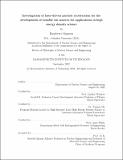| dc.contributor.advisor | Winslow, Lindley | |
| dc.contributor.advisor | Ma, Tammy | |
| dc.contributor.author | Simpson, Raspberry | |
| dc.date.accessioned | 2023-01-19T18:48:26Z | |
| dc.date.available | 2023-01-19T18:48:26Z | |
| dc.date.issued | 2022-09 | |
| dc.date.submitted | 2022-10-12T19:35:09.877Z | |
| dc.identifier.uri | https://hdl.handle.net/1721.1/147365 | |
| dc.description.abstract | Since the innovation of chirped pulse amplification by Donna Strickland and Gerard Morou in 1985, laser technology has evolved such that we can create short pulses of light (10⁻¹⁵ − 10⁻¹² seconds) with high peak powers (1015 Watts) in small, focused spots (∼a few microns). A prolific area of research that has emerged over the last two decades is the use of these high-intensity lasers to drive particle beams. Possible applications of these particle sources include isotope production for medical applications, proton cancer therapy, and fusion energy schemes. This thesis focuses on laser-driven proton acceleration and adds to the existing foundation of work in the area by investigating new empirical relationships, conducting new measurements of the accelerating electric field responsible for laser-driven proton acceleration, and developing a new data analysis methodology using machine learning. This work first examines laser-driven proton acceleration in the multi-picosecond regime (>1ps) at laser intensities of 10¹⁷ − 10¹⁹ W/cm². This is motivated by recent results on laser platforms like the National Ignition Facility-Advanced Radiographic Capability laser and the OMEGA-Extended Performance laser, which have demonstrated enhanced accelerated proton energies when compared to established scaling laws. A detailed scaling study was performed on the Titan laser, which provided the basis for a new analytical scaling presented in this thesis. In addition, high-repetition-rate (HRR) lasers that can operate at 1 Hz or faster are now coming online around the world, opening a myriad of opportunities for accelerating the rate of learning on laser-driven particle experiments. To unlock these applications, HRR diagnostics combined with real-time analysis tools must be developed to process experimental measurements and outputs at HRR. Towards this goal, this thesis presents a novel automated data analysis framework based on machine learning and proposes a new methodology based on representation learning to integrate heterogeneous data constrain parameters that are not directly measurable. Taken together, these thrusts enable a new preliminary framework for enhanced analysis of complex HRR experiments and a foundational step towards realizing the goal of tunable laser-driven particle sources. | |
| dc.publisher | Massachusetts Institute of Technology | |
| dc.rights | In Copyright - Educational Use Permitted | |
| dc.rights | Copyright MIT | |
| dc.rights.uri | http://rightsstatements.org/page/InC-EDU/1.0/ | |
| dc.title | Investigation of laser-driven particle acceleration for the development of tunable ion sources for applications in high energy density science | |
| dc.type | Thesis | |
| dc.description.degree | Ph.D. | |
| dc.contributor.department | Massachusetts Institute of Technology. Department of Nuclear Science and Engineering | |
| mit.thesis.degree | Doctoral | |
| thesis.degree.name | Doctor of Philosophy | |
